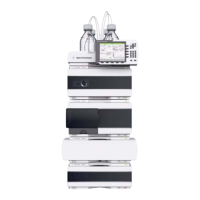1260 Infinity Micro Degasser Service Manual 37
Using the Micro Vacuum Degasser
4
Solvent Information
Stainless Steel (SST)
Stainless steel is inert against many common solvents. It is stable in the
presence of acids and bases in a pH range of 1 to 12.5 . It can be
corroded by acids below pH 2.3 . It can also corrode in following solvents:
• Solutions of alkali halides, their respective acids (for example, lithium
iodide, potassium chloride, and so on) and aqueous solutions of
halogens.
• High concentrations of inorganic acids like nitric acid, sulfuric acid and
organic solvents especially at higher temperatures (replace, if your
chromatography method allows, by phosphoric acid or phosphate buffer
which are less corrosive against stainless steel).
• Halogenated solvents or mixtures which form radicals and/or acids, for
example:
2 CHCl
3
+ O
2
→ 2 COCl
2
+ 2 HCl
This reaction, in which stainless steel probably acts as a catalyst,
occurs quickly with dried chloroform if the drying process removes the
stabilizing alcohol.
• Chromatographic grade ethers, which can contain peroxides (for
example, THF, dioxane, di- isopropylether). Such ethers should be
filtered through dry aluminium oxide which adsorbs the peroxides.
• Solutions of organic acids (acetic acid, formic acid, and so on) in
organic solvents. For example, a 1 % solution of acetic acid in methanol
will attack steel.
• Solutions containing strong complexing agents (for example, EDTA,
ethylene diamine tetra- acetic acid).
• Mixtures of carbon tetrachloride with 2- propanol or THF.
Diamond-Like Carbon (DLC)
Diamond- Like Carbon is inert to almost all common acids, bases and
solvents. There are no documented incompatibilities for HPLC applications.
Fused silica and Quartz (SiO
2
)
Fused silica is used in 1290 Infinity Flow Cells and capillaries. Quartz is
used for classical flow cell windows. It is inert against all common
solvents and acids except hydrofluoric acid and acidic solvents containing

